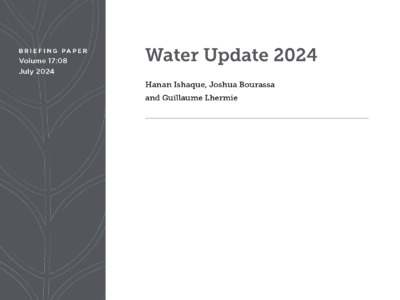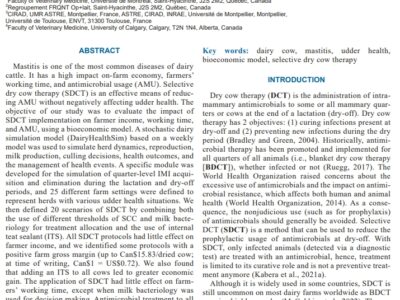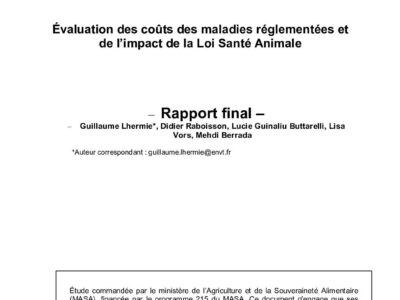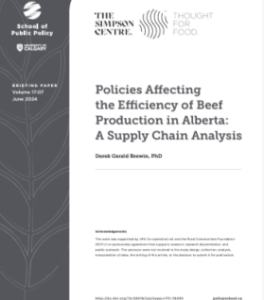Publications
The Water Wealth in Agriculture event was hosted in October 2022 in conjunction with the University of Calgary’s Simpson Centre, Schulich School of Engineering, Faculty of Science, and the University of Saskatchewan’s Global Institute for Water Security. It invited a diverse set of expert stakeholders from industry, government, and research (see annex) to discuss sustainable water management for agriculture. This paper summarizes the opinions and suggestions of the diverse interest groups attending the event about recent and current action on sustainable water practices.
Tuesday, July 16, 2024
Hanan Ishaque, Joshua Bourassa and Guillaume Lhermie
The focus of this paper is to determine whether earmarking health taxes or other revenue mobilizes greater public healthcare support as argued by the World Health Organization. We examine six case studies in which taxes or revenues have been earmarked to support public healthcare: Brazil, France, Germany, the Philippines, South Africa, and South Korea. We find that earmarking does not lead to more revenue spent on healthcare on a sustained basis, except for experiences in the Philippines and for long-term care in Germany.
Wednesday, July 10, 2024
Janice MacKinnon, Jack M. Mintz, and Mukesh Khanal
Mastitis is one of the most common diseases of dairy cattle. It has a high impact on-farm economy, farmers’ working time, and antimicrobial usage (AMU). Selective dry cow therapy (SDCT) is an effective means of reducing AMU without negatively affecting udder health. The objective of our study was to evaluate the impact of SDCT implementation on farmer income, working time, and AMU, using a bioeconomic model. A stochastic dairy simulation model (DairyHealthSim) based on a weekly model was used to simulate herd dynamics, reproduction, milk production, culling decisions, health outcomes, and the management of health events. A specific module was developed for the simulation of quarter-level IMI acquisition and elimination during the lactation and dry-off periods, and 25 different farm settings were defined to represent herds with various udder health situations. We then defined 20 scenarios of SDCT by combining both the use of different thresholds of SCC and milk bacteriology for treatment allocation and the use of internal teat sealant (ITS). All SDCT protocols had little effect on farmer income, and we identified some protocols with a positive farm gross margin (up to Can$15.83/dried cow; at time of writing, Can$1 = US$0.72). We also found that adding an ITS to all cows led to greater economic gain. The application of SDCT had little effect on farmers’ working time, except when milk bacteriology was used for decision making. Antimicrobial treatment to all cows above 200,000 cells/mL at last control, with the use of ITS on all cows, seems a good choice in most dairy farms. These findings could be used to convince farmers to adopt this strategy at dry-off.
Thursday, June 20, 2024
Thomas Le Page, Ahmed Ferchiou, Simon Dufour, Fidèle Kabera, Jocelyn Dubuc, Guillaume Lhermie, Didier Raboisson, and Jean-Philippe Roy
La “loi de santé animale” (règlement (UE) 2016/429) impacte les politiques publiques de surveillance, de prévention et de lutte conte les maladies animales, en mettant particulièrement en avant la biosécurité. Cette étude avait plusieurs objectifs : estimer les coûts de la lutte contre les maladies animales réglementées dans différentes filières, analyser leur ventilation par partie prenante et évaluer les impacts socio-économiques de l’application de cette loi.
Étude réalisée par l’École nationale vétérinaire de Toulouse. Financement : ministère de l’Agriculture et de la Souveraineté alimentaire.
Source: Ministère de l’Agriculture et de la Souveraineté alimentaire
Monday, June 17, 2024
Guillaume Lhermie, Didier Raboisson, Lucie Guinaliu Buttarelli, Lisa Vors, and Mehdi Berrada
The global food system refers to the interconnected network of production, distribution, and consumption of food on a worldwide scale. Its objective is to ensure food security. Over the last 50 years, continuous improvements in farming methods, new technologies, and infrastructure capacity in international supply chains have allowed for a more affordable and safer food supply for an increasing global population. This has fostered domestic and foreign political stability. Fueled by the liberalization of exchanges and the rise of agri-food giants, and under the influence of cheap fossil fuels and mineral fertilizers, agricultural systems worldwide have converged towards industrial agriculture to feed a growing population that is also adopting similar food habits. Globalization and large-scale public policies have enabled billions of people to escape food insecurity, mostly in low- and middle-income countries. However, food security has come at a large environmental cost and has not always been successful in terms of equity. Particularly in Western countries, unhealthy and unsustainable diets are becoming the norm, while producers are caught in the crossfire between more stringent environmental policies and the economic push for competitiveness in international markets.
Saturday, June 01, 2024
Guillaume Lhermie
Shoppers face high beef prices at the supermarket, but those prices are not a reflection of what Canadian farmers and ranchers earn from their cow-calf herds. In the past 30 years, the average beef producer’s operating margin has never reached $50,000, despite the fact that the average beef farm’s asset base stands at more than $2 million.
Better access to export markets, including the U.S., South Asia and North Africa, would help to remedy the producers poor returns. Export prices would need to cover production costs, the largest of which is feed for the producers’ cattle herds, accounting for 77 per cent of the average ranch’s cash costs.
Saturday, June 01, 2024
Derek Gerald Brewin, PhD





